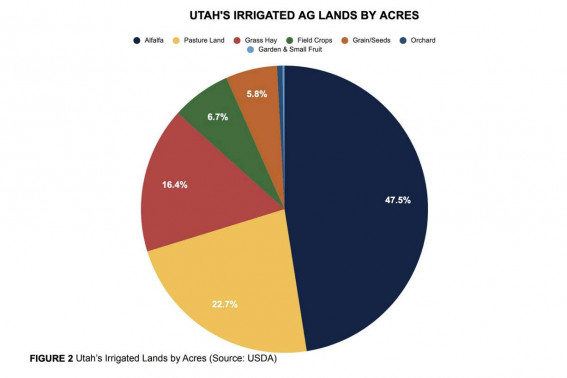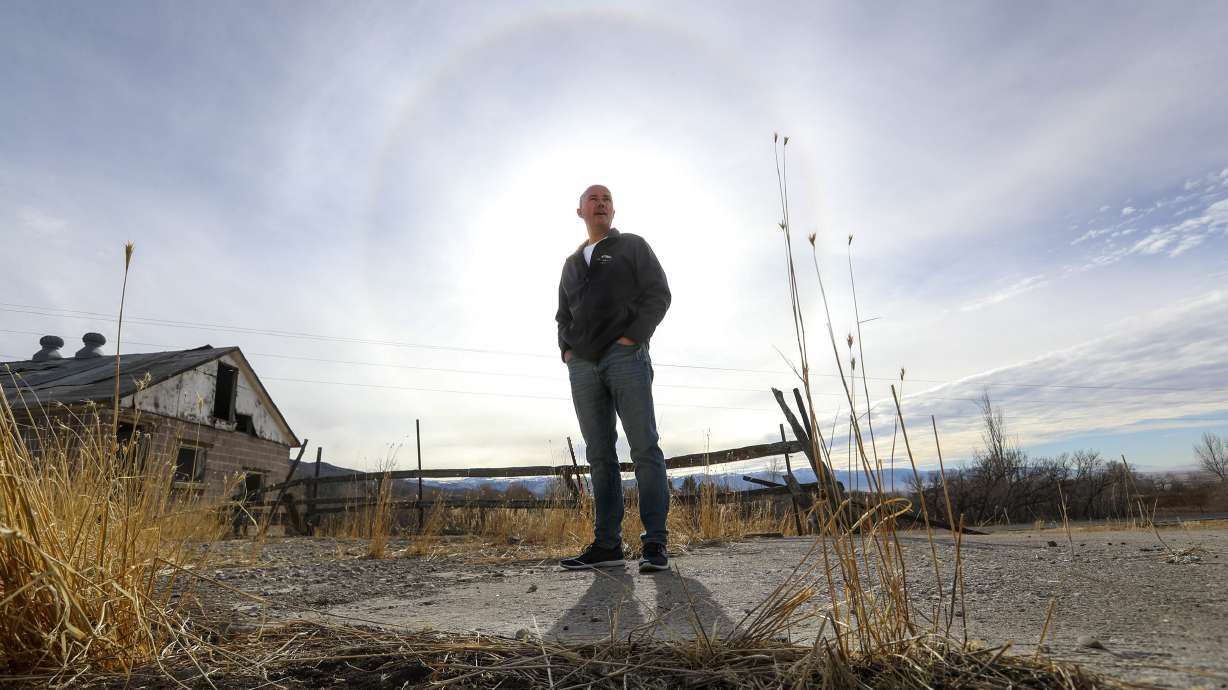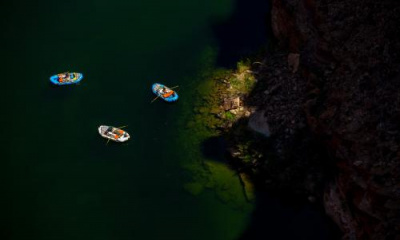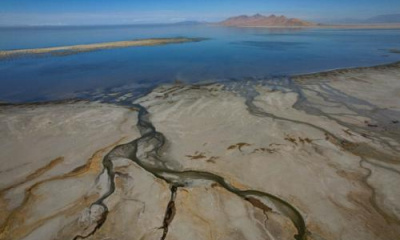SALT LAKE CITY — Given Utah's ongoing drought and the two-decade-long "megadrought," Utah Gov. Spencer Cox believes that Utahns must view water differently than ever before, cutting back on water waste and being more efficient with available water.
"This is a human change that has to happen. It's a paradigm shift, not just with lawmakers … (but) everyone who lives here," he said, during an interview for the Great Salt Lake Collaborative last week. "Getting 3 million (people) to change that paradigm is tough but we're getting there."
While the state typically emphasizes conservation through various ways homeowners and businesses can cut back, such as using less water on lawns, most of Utah's water goes to the farmers and ranchers. A 2015 study found that agriculture accounts for about 80% of Utah's water consumption, though some reports have the figure ranging between 75% and 85%.
Craig Buttars, the commissioner of the Utah Department of Agriculture and Food, contends that the paradigm shift Cox spoke about is already happening within the agricultural community because they are feeling the pinch as a result of the drought.
"A lot of farmers are considering the crops that they're growing and trying to find ways to grow more water-efficient crops to still meet the needs that they have for watering their livestock," Buttars said. "It's been a gradual paradigm shift. ... Over the past 10 to 20 years, we've seen a lot more interest in greater efficiency."
Optimizing agricultural water use
The governor on Wednesday unveiled the third chapter of Utah's water plan, which focuses on future agricultural water use. It heavily promotes ideas to optimize water use, something that's already in motion.
The state agriculture department recently awarded a little more than $25.5 million to about 140 projects that qualified for its water optimization grant program. Combined, the projects are projected to reduce water consumption by about 32% within the selected areas, which cover more than 350,000 acres in the state.
The program has saved about 21,000-acre-feet, or about 7 billion gallons of water since it began in 2019, according to Buttars. Another round of funding begins next week, which is expected to result in many more water-saving projects across the state.
A lot of farmers have seen increased production on actually using less water — about a third of an increase in production on their crops while also using a third less water.
–Craig Buttars, Utah Department of Agriculture and Food
Kenny McFarland, who works at Onions 52 in Syracuse, is one of the many Utah farmers who have decided to rethink the way they grow crops because of the drought. He told KSL-TV in March that he switched to a drip irrigation system, which reduces the amount of water lost through evaporation.
Other farmers have done the same or looked at other ways to reduce water consumption, such as adding piping to ditches and canals. Meanwhile, some have switched to crops, like barley or wheat, that can be planted in the fall and absorb winter moisture before they are harvested in the spring ahead of the traditional growing season.
Buttars said these changes haven't only been more efficient, but they've also helped farmers and ranchers become more productive.
"A lot of farmers have seen increased production on actually using less water — about a third of an increase in production on their crops while also using a third less water," Buttars added.
The Agricultural Water Optimization Task Force, a group Utah formed to project agricultural water needs in the future, issued a report at the end of last year that found "immediate action that optimizes the use and management of our finite water supplies is needed" to avoid issues related to long-term climate trends and "relentless pressure" from population growth.
The report added that Utah should make "significant" investments now instead of in the future. The Utah Legislature responded by sending a record $70 million to the program this year.
Is it making an impact?
While these programs have helped reduce water use, conservation groups argue more needs to be done.
Zach Frankel, the executive director of the environmental nonprofit Utah River Council, says one issue is some of these projects should have been done much sooner, not 20 years into the megadrought. In addition, they aren't saving quite enough water needed to save vital rivers and lakes, like the Great Salt Lake.
"We're taking baby steps forward, but they're baby steps," he said. "When your child takes their first step, that's great. But when your child is competing with college students who took their baby steps 20 years ago, it's not much to celebrate."
Another issue is that Utah has only scratched the surface of its optimization process. About $76 million has gone into the state's program since it began in 2019; however, Cox's water plan acknowledges that there is over $1 billion needed to upgrade "antiquated" irrigation systems and $5 billion needed to improve conveyance systems, like piping canals, per the recommendation of the Water Optimization Task Force.
This graphic, created by the Governor's Office of Planning and Budget, shows the percentage of land used for every agricultural product grown in the state. Alfalfa (47.5%) has the largest share of land use that is irrigated. 
(Photo: Governor's Office of Planning and Budget)
Several organizations have also argued that Utah needs to back away from growing crops like alfalfa, which accounts for nearly half of all agricultural land use. In fact, alfalfa takes up about double the land use of pasture land, the second-largest agricultural land user, according to the new state water plan document.
The state document adds that alfalfa is "a thirsty crop that requires more water than other potential crops," which is why a large chunk of the state's agricultural water goes toward growing it.
Cox, a farmer himself, is quick to defend agricultural water use, though. He argues that the supply chain issues that emerged during the COVID-19 pandemic exemplify why local food production is important, including growing crops that go toward feeding livestock, such as alfalfa.
The governor supports optimization because he said it helps reduce water use while still providing a public good.
"Food is just as important as water, and you can't get food without water," he said, adding that only "a very, very small percentage" of that is shipped overseas. "So you can't take water completely away from agriculture."
But Frankel's largest criticisms are Utah's water rights marketplace — which he argues encourages more water consumption — and the lack of long-term planning with any water that is saved through optimization.
Utah's water rights laws were tweaked this year with the drying Great Salt Lake in mind. HB33, which the Utah Legislature passed earlier this year to help allow water rights users, like farmers and ranchers, to lease their rights to organizations for conservation purposes, like allowing water to flow directly into the Great Salt Lake, but it doesn't allow for permanent rights to go directly to the lake.
The temporary leases can only continue for up to 10 years, and Frankel said there really aren't any legal rights for inflow stream water rights beyond that. Without a permanent designation, Frankel believes that it's difficult to guarantee the law will improve the cause that inspired it: saving the Great Salt Lake.
"The reason Zion National Park exists today is because it was permanently protected," he said. "Congress did not issue social media streams about the need to protect Zion National Park. They did not hold press conferences about the need to protect Zion National Park. They passed a bill that permanently designates Zion National Park, and that's why it's still there."
The future of Utah farming
It's impossible to know how long current drought conditions will last, though an escape may not last long.
A NASA Goddard Institute for Space Studies-led study published last year suggests that soil moisture levels in Utah, and across the Southwest, will continue to dry in the next century. It also projects a 50% probability that another megadrought event like the one the Southwest is currently facing will appear again by the end of this century as a result of climate change.
Buttars said another threat is the urbanization of Utah's "most productive" farm lands. Since he doesn't see the need for agriculture changing in the future, these two issues are why he believes the future of farming in Utah will need more optimization projects and creativity to use water efficiently.
That said, he's sure Utah farmers and ranchers are up to the task.
"Farmers are quite good at adapting," he said. "We'll continue to adapt and adjust in any ways that we can."
Though he says Utah has a long way to go regarding how it uses agricultural water, Frankel says he does believe Utah is turning a page on how it views water altogether. He's been a water conservation advocate for over two decades and can't remember a time Utah leaders have been as interested in the subject as they are now.
He's hopeful that the interest will translate into policies that will benefit all water users and natural bodies of water.
"There is no question that there is common ground available for the state government to lead the way in providing both a sustainable water supply," he said, "and a well-protected set of river and lake ecosystems."









